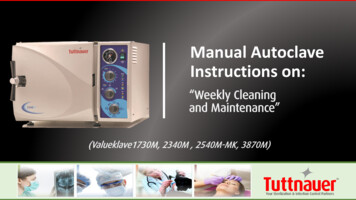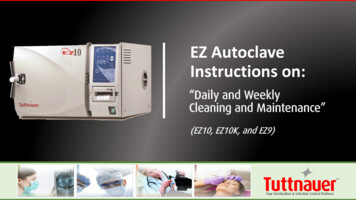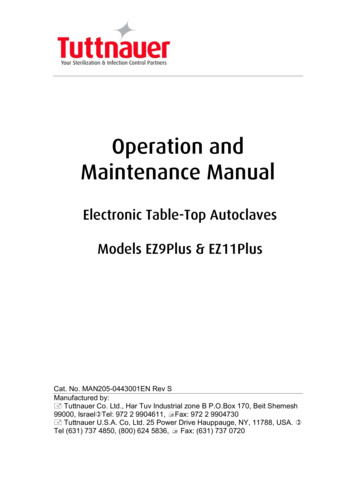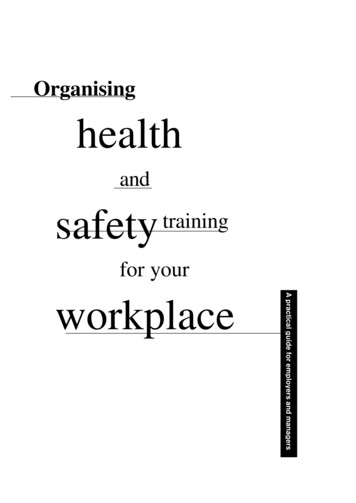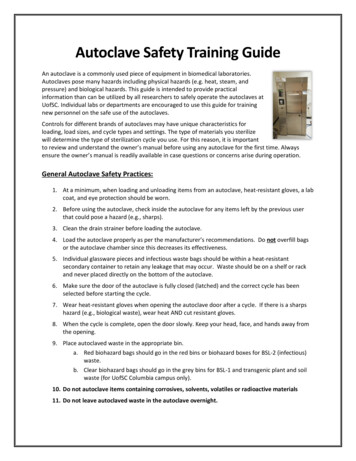
Transcription
Autoclave Safety Training GuideAn autoclave is a commonly used piece of equipment in biomedical laboratories.Autoclaves pose many hazards including physical hazards (e.g. heat, steam, andpressure) and biological hazards. This guide is intended to provide practicalinformation than can be utilized by all researchers to safely operate the autoclaves atUofSC. Individual labs or departments are encouraged to use this guide for trainingnew personnel on the safe use of the autoclaves.Controls for different brands of autoclaves may have unique characteristics forloading, load sizes, and cycle types and settings. The type of materials you sterilizewill determine the type of sterilization cycle you use. For this reason, it is importantto review and understand the owner’s manual before using any autoclave for the first time. Alwaysensure the owner’s manual is readily available in case questions or concerns arise during operation.General Autoclave Safety Practices:1. At a minimum, when loading and unloading items from an autoclave, heat-resistant gloves, a labcoat, and eye protection should be worn.2. Before using the autoclave, check inside the autoclave for any items left by the previous userthat could pose a hazard (e.g., sharps).3. Clean the drain strainer before loading the autoclave.4. Load the autoclave properly as per the manufacturer’s recommendations. Do not overfill bagsor the autoclave chamber since this decreases its effectiveness.5. Individual glassware pieces and infectious waste bags should be within a heat-resistantsecondary container to retain any leakage that may occur. Waste should be on a shelf or rackand never placed directly on the bottom of the autoclave.6. Make sure the door of the autoclave is fully closed (latched) and the correct cycle has beenselected before starting the cycle.7. Wear heat-resistant gloves when opening the autoclave door after a cycle. If there is a sharpshazard (e.g., biological waste), wear heat AND cut resistant gloves.8. When the cycle is complete, open the door slowly. Keep your head, face, and hands away fromthe opening.9. Place autoclaved waste in the appropriate bin.a. Red biohazard bags should go in the red bins or biohazard boxes for BSL-2 (infectious)waste.b. Clear biohazard bags should go in the grey bins for BSL-1 and transgenic plant and soilwaste (for UofSC Columbia campus only).10. Do not autoclave items containing corrosives, solvents, volatiles or radioactive materials11. Do not leave autoclaved waste in the autoclave overnight.
Additional Practices for Autoclaving Liquids:1. When running an autoclave cycle with liquids, the cycle time is longer, but uses lowertemperatures to minimize evaporation of the liquids being sterilized.2. Fill liquid containers only ½ full. Remove or loosen the caps on containers to prevent bottlesfrom shattering during pressurization.3. Use only borosilicate glass (Pyrex or Kimax ) which can withstand the high autoclavetemperatures.4. Use a tray with a solid bottom and walls to contain the contents and catch spills.5. Wait 10 minutes before removing autoclaved items.6. Let liquids stand for a full hour before touching with ungloved hands. Be sure others in the areaknow a heat hazard is present.Additional Practices for Autoclaving Dry Loads:1. Add ¼ to ½ inch of water to the tray so the bottles heat evenly.2. Check plastic materials to ensure they are compatible with the autoclave.3. Wait 5 minutes before removing autoclaved items.4. For dry loads, let the glassware cool for 15 minutes before touching it with ungloved hands.Autoclave Monitoring & Maintenance:Autoclave monitoring and maintenance is an important aspect of a properly functioning autoclave.Follow the manufacturer’s recommendations for preventive maintenance and ensure all contractorsauthorized to service an autoclave have the appropriate qualifications and experience.Autoclave operators should ensure that each autoclave is monitored as follows:Heat Sensitive Tape MonitoringOperators should use heat-sensitive sterilization indicator tape for each load to indicate that the propertemperature of 121 C has been reached. The visual indicator is often a color or pattern change on thetape. This tape does not indicate waste was heated for the proper length of time to achieve sterilization.Do not use autoclave tape as the only indicator of sterilization and decontamination of infectious waste.Additional monitoring is not required because all red bag infectious waste is picked up by EHS afterautoclaving and removed from campus by an infectious waste vendor for incineration.RecordkeepingOperators should maintain documentation of any autoclave preventative maintenance or repairs. Theserecords should indicate who performed the work, the type of maintenance or repairs conducted, andthe date the autoclave was serviced. The records should be maintained either in the room with the
autoclave, or signage should be posted indicating the location of any records that document autoclavemaintenance or repairs.TrainingEach laboratory or department must develop and implement an autoclave safety training program. Allusers must be trained before operating an autoclave and the laboratory PI/supervisor or departmentaltrainer is responsible for ensuring each person is appropriately trained. Training must be documented,and records should be maintained in the lab with your other safety training certificates. The laboratoryPI/supervisor or departmental trainer is encouraged to use this guide for training new personnel.Autoclave FailureDiscontinue use immediately if an autoclave is not working properly. Post a sign that alerts others not touse the autoclave. Mechanical failure needs to be attended by a trained technician. Contact the servicecompany responsible for maintenance of your autoclave. If your autoclave is not on a service contract,you should contact your facilities manager or departmental safety representative for further guidance.Biological Indicator Monitoring & Other Infectious Waste Disposal Considerations Departments of Facilities Management can document periodic (at least monthly) testing toverify proper autoclave performance using heat-resistant bacterial spores (e.g., Geobacillusstearothermophilus). This method of testing verifies the cycle time, temperature and pressurewere effective to kill this heat-resistant microorganism. Biological indicators should beperiodically used to verify effective decontamination of infectious waste. EHS recommends that department chairs maintain a service contract for preventativemaintenance on any autoclaves used by personnel working in their laboratories. Several factors can impact the length of time required to achieve sterilization. EHS recommendsthat researchers use a cycle time of at least 60 minutes for appropriate decontamination. Autoclaves record the time, temperature and pressure attained during each cycle. All red bag infectious waste is picked up by EHS after autoclaving and removed from campus byan infectious waste vendor for incineration. Therefore, this autoclaving is not considered“treatment”. Onsite treatment of infectious waste would be used to render the infectious wasteas no longer infectious (i.e., regular trash) and this process requires the implementation of awritten quality assurance plan. This quality assurance plan would need to be managedconsistently for all campus autoclaves used for treatment of infectious waste and appropriatedocumentation would be required. EHS will continue to have all infectious waste picked up byan infectious waste disposal vendor for incineration until a centralized quality assurance plan isimplemented. Implementing this plan would require participation from all stakeholders. The documentation for a quality assurance plan may include records such as the following:o An autoclave service contract for preventative maintenance.o Documentation of all autoclave maintenance or repairs.o Routine monitoring using heat-sensitive tape for each load.o Printouts of the cycle time, temperature and pressure for each load.o Personnel training records on autoclave use policies and procedures.o Records for heat-resistant bacterial spore testing at least monthly.
Emergency ProceduresBurn EmergencyIf you are burned, you should seek medical treatment as soon as possible. Burns to the face, thirddegree burns, or burns over large areas of the body should be treated as emergencies. Minor burnsshould be treated by using first aid procedures. These procedures would include immersing the burn incool water immediately, removing clothing from the burn area, and keeping the injured area cool for atleast five minutes (preferably longer). Any burns to the face or eye or any burns that blister should beseen by a physician. Regardless of the degree of severity, report the burn to your lab supervisor orPrincipal Investigator as an occupational injury.SpillsClean up of spills that occur during the use of the autoclave is the responsibility of the individual whocaused the spill. Assist anyone who may have been contaminated or injured during the spill. Clean upminor spills outside the autoclave using the appropriate biohazard spill clean-up materials andprocedures. If broken glass or other sharps are present, remove with a brush and dustpan, tongs, orforceps. Contaminated sharps should be placed in a puncture-resistant biohazard sharps container. Forspills inside the autoclave, wait until autoclave and materials have cooled to room temperature prior tocleaning up the spill. Clean up the spill inside the autoclave using absorbent material or a lab spill kit.Roles & Responsibilities for Autoclave SafetyBiological Safety Office Maintain an Autoclave Safety Training Guide that describes general policies and procedures forlaboratory personnel to safely use an autoclave. Provide guidance to laboratory personnel when questions arise regarding proper autoclaving ofinfectious waste or compliance requirements.Department Chair Notify Principal Investigators in your department if hands-on autoclave training should beprovided by each PI for their lab staff or if you have appointed a departmental trainer. Ensure autoclaves used by personnel in your department are on a service contract.Department/Laboratory Autoclave Trainer Provide hands-on training for the proper use of specific autoclaves used by lab personnel.Answer any laboratory personnel questions on the proper use of specific autoclaves.Laboratory Personnel Follow all autoclave safety procedures defined in this guide and in the hands-on training.Report incidents involving the use of autoclaves to your lab supervisor and follow incidentreporting procedures if an injury occurs when using the autoclave.
Autoclave Training DocumentationInstructions: Individuals that will be using an autoclave should have documentation of training.This training should include reviewing and verifying understanding of proper autoclave safetypractices and procedures. Please review the statements below and select all that apply. Pleasenotify your Department/Laboratory Autoclave Trainer to complete your required training ifyour training has not included all the training requirements described below. This trainingdocumentation must be signed by both the department/laboratory autoclave trainer andauthorized user. A copy of this training documentation must be maintained in the lab as theindividual’s official record of training. I have reviewed and understand the safety practices and procedures outlined in theAutoclave Safety Training Guide. I have received hands-on training regarding proper use of the autoclave, necessaryprecautions to prevent exposures or injuries (e.g. burns), and procedures to follow if anincident occurs (e.g. spills, autoclave failure). I have demonstrated proficiency in the procedures for operating the autoclave and havehad the opportunity to ask questions regarding how to safely use the autoclave.Department/Laboratory Autoclave TrainerNameSignatureAuthorized User:NameSignatureDate
List of Trained and Authorized Autoclave Users in My Laboratory/DepartmentAs the Departmental/Laboratory Autoclave Trainer, I acknowledge that I have provided hands-ontraining to the following individuals on the proper and safe use of the autoclave, necessary precautionsto prevent exposures or injuries, and the procedures to follow if an incident occurs. I have also verifiedthe following authorized users have demonstrated proficiency operating the autoclave they will use.Departmental/Laboratory Autoclave Trainer:Authorized Autoclave Users:NameSignatureDate (Month/Day/Year)
This training documentation must be signed by both the department/la boratory autoclave trainer and authorized user. A copy of this training documentation must be maintained in the lab as the individual's official record of training. I have reviewed and understand the safety practices and procedures outlined in the Autoclave Safety Training .
